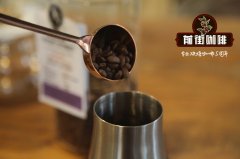Yemeni Mocha Coffee Yemen Mocha Brand introduces the flavor characteristics of Matali Mattari coffee

Professional coffee knowledge exchange more coffee bean information please follow the coffee workshop (Wechat official account cafe_style)
Yemeni mocha coffee (Yemen Mocha)
Yemen, located by the Red Sea, is an ancient Arab country. Since ancient times, Yemeni coffee has been grown by itself, and the whole process of cultivation and treatment depends entirely on manual work. Coffee beans are naturally dried in the sun, and the beans are small and strong. Originated from the Yemeni city of Muke, so Yemeni coffee is mocha coffee. Yemeni coffee is a traditional high-quality coffee with a special clear taste, with a hint of wine flavor and natural sour taste. We choose Mattari No.9, which is recognized as the best, with rich texture, excellent meek taste, fruit-like sweet smell, and enjoy with you.
Origin: Matali (Mattari) producing area of Bany Matar province in northern Yemen < Yemen is a South-West Asian country. >
Height: 1000-3000 m
Yemeni mocha has always been my favorite, and there are very few coffee with wild, game, wine, fig, mild, changeable, and strong chocolate flavor at the same time. The Yemeni mocha, once praised as an Arab wine, is a gift from Allah. Precisely because the original coffee trade was exported from the Yemeni port of Mocha, many people mistakenly think that Yemen is the birthplace of coffee. Up to now, some Europeans are still used to calling coffee mocha. Since the 17th century, coffee beans grown in dry Arabian soil and lack of moisture in the air have been particularly hard and small. Mocha production has been limited by local political upheaval and uneconomical planting. Among them, the Yemeni mocha is represented by the Mattari produced in Bani Matar, which has a sweet, smooth and unique flavor. Slightly sour and strong aftereffect, I think it is the most suitable coffee to drink after a meal, and it is also the best in mocha.
Yemen's crude and primitive coffee-growing methods have improved slightly over the centuries. Coffee trees are planted in small parks on steep slopes, which are inaccessible areas. The coffee beans grown here are very hard and small because of the dry Arab soil and lack of moisture in the air. The elaborate irrigation system diverts the spring to a trapezoidal coffee garden surrounded by soil and low walls. All this work is done by manpower. Coffee beans are mostly sunburned on the roof or flat ground. Oddly enough, coffee drinks are not very popular in the area where coffee was first drunk, and the way coffee is made is terrible. Coffee juice is usually boiled in bean clips. Small farm farmers are more attentive to cultivating a medicinal plant called qat, because it is popular to chew quarts and neglect coffee trees. Mocha production is still limited by local political upheaval and uneconomical cultivation. Mocha coffee was named after the Yemeni mocha (Moka), the earliest coffee export port, supplying global coffee commercial transactions until the end of the 17th century.
Qianjie coffee: Guangzhou bakery, the store is small but a variety of beans, you can find a variety of unknown beans, but also provide online store services. Https://shop104210103.taobao.com
Important Notice :
前街咖啡 FrontStreet Coffee has moved to new addredd:
FrontStreet Coffee Address: 315,Donghua East Road,GuangZhou
Tel:020 38364473
- Prev

Historical story flavor characteristics of Mattari Matali / Matali coffee cultivation in Yemeni coffee producing area
Professional coffee knowledge exchange more information about coffee beans Please follow the coffee workshop (Wechat official account cafe_style) Matari Yemen is located in West Asia, just one step away from the African continent. Without the promotion of Islamic priests in the Arabian Peninsula, coffee might still be a wild plant in Ethiopia. Legend has it that coffee was handed down in Ethiopia in the sixth century.
- Next

Yemeni Coffee characteristic Flavor Coffee cultivation introduction to the reasons why Yemeni coffee is expensive
Professional coffee knowledge exchange more information about coffee beans Please follow the coffee workshop (Wechat official account cafe_style) real Yemeni coffee is not common. After the fruit is ripe on the trees, the farmers harvest it by hand and dry it on the roof of the stone house built by the mountain. The process of shelling meat depends entirely on crude stone grinding equipment. Due to inconvenient transportation, coffee usually changes hands several times on the way.
Related
- Detailed explanation of Jadeite planting Land in Panamanian Jadeite Manor introduction to the grading system of Jadeite competitive bidding, Red bid, Green bid and Rose Summer
- Story of Coffee planting in Brenka region of Costa Rica Stonehenge Manor anaerobic heavy honey treatment of flavor mouth
- What's on the barrel of Blue Mountain Coffee beans?
- Can American coffee also pull flowers? How to use hot American style to pull out a good-looking pattern?
- Can you make a cold extract with coffee beans? What is the right proportion for cold-extracted coffee formula?
- Indonesian PWN Gold Mandrine Coffee Origin Features Flavor How to Chong? Mandolin coffee is American.
- A brief introduction to the flavor characteristics of Brazilian yellow bourbon coffee beans
- What is the effect of different water quality on the flavor of cold-extracted coffee? What kind of water is best for brewing coffee?
- Why do you think of Rose Summer whenever you mention Panamanian coffee?
- Introduction to the characteristics of authentic blue mountain coffee bean producing areas? What is the CIB Coffee Authority in Jamaica?

